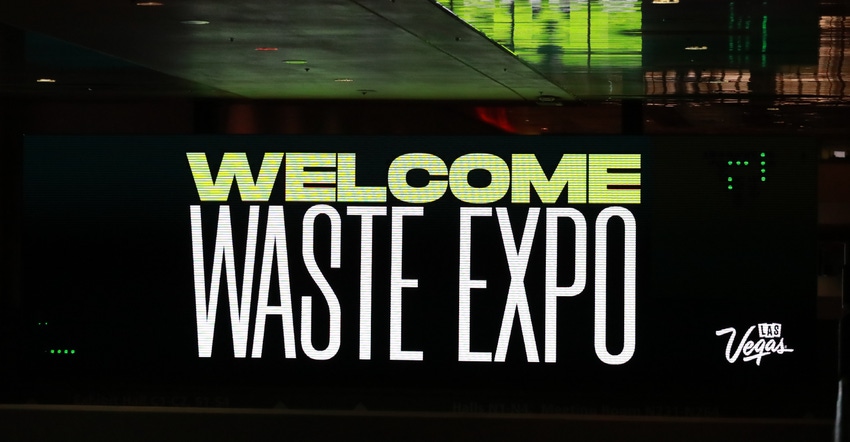
Experts in recycled polypropylene (PP), PET, and HDPE discussed supply and demand, technologies, recycling infrastructure, and evolving legislation around these materials at last Wednesday’s WasteExpo session: Commodities Updates, End Markets & Export Opportunities (part two).
Attendees got perspective on ways to design and reuse plastics to create a circular economy. The session was moderated by Anne Germain, COO & senior vice president of Technical and Regulatory Affairs, National Waste & Recycling Association. Speakers included Sally Houghton, deputy executive director, Plastic Recycling Corporation of California (PRCC); Tamsin Ettefagh, chief sustainability officer, PureCycle Technologies; and JD Lindeberg, president RRS.
Houghton kicked off the session by stating that California in particular has seen substantial growth in plastic recycling markets. The nonprofit membership organization she works for sells PET and works to improve recycling system efficiency and markets for this material.
“We bought [PET] at a loss in the beginning to create demand and now there is strong recycling infrastructure in California. There are six reclaimers in California working with PET that can take most if not all of what is collected in the state, and they need more,” Houghton said.
But she emphasized that increasing scrap value is essential as is reducing system costs. PRCC tries to reduce those costs by matching material with reclaimers.
She moved on to discuss networking with all the players in the system.
“We have relationships throughout the [supply] chain. We talk about designing for recyclability, and we talk to processors about how they sort and collect/operate.”
California’s plastics recyclers and processors are finding opportunity in more than PET, with HDPE and PP gaining traction too.
Ettefagh told some of the story of PureCycle, which uses proprietary technology licensed from Procter & Gamble. The technology is a purification process to recycle waste PP into virgin-quality material.
The first plant will be operational in 2022 and make over 100 million pounds of what PureCycle calls “Ultra-Pure Recycled Polypropylene” (UPRP) annually, though the plan is to build out one billion pounds of capacity that same year.
The recycled PP market has a huge opportunity to grow, but in general it’s difficult to find enough of certain types for food grade and difficult to make it colorless, which are two challenges the technology addresses, Ettefagh said.
“We take any polypropylene content. We will go after other materials rather than just curbside and formats beyond bottles. We are open to bulky ridges and tubs (etc.) I hope we can bring security [to recyclers] in letting them know that we can sell whatever PP is brought to us,” she said.
With COVID-19 there has been a spike in PP takeout containers and some other packaging. There is a tremendous volume now, and it’s in demand.
“We all need more supply so consumer product companies can make their goals. If they can’t make their goals, I am concerned they will change their content, and that it won’t be recyclable,” Ettefagh said.
She also sees urgency driven by legislation to require recycled content in packaging. California lawmakers approved legislation last year requiring all plastic bottles covered by the state’s container redemption program average at least 15% post-consumer resin starting in 2022. That recycled-content mandate increases over time.
“So, we need that food grade content. We need more supply to make economics work. I think this [early] period [of scaling] will be expensive, but it will level out once we get supply up,” Ettefagh projected.
She is encouraged by a trend where some companies that make or use virgin plastics are getting into recycling, commenting that their engineers know the technologies and materials and their capabilities. “So, I think we have great opportunity to see [materials] evolve and to make it easier for consumers to participate,” she said.
Lindeberg pointed out that PP is a fairly new entry in the recycling world; it’s been collected at curbside for about 10 years.
“Polypropylene has remarkable characteristics [and function] that can’t be done with some other plastics, so it is here to stay,” he said. He told attendees that he would like to see a PP recycling commission come together and to see increased investments in MRFs.
Lindeberg also broached potential fraud around recycling and the role technology can play to mitigate it, including artificial intelligence systems, scanning technology, and blockchain apps to precisely identify and document material moving through the system.
He had advice for operators on how to determine what technology to bring in.
“You want to look at what material you are getting and what it sells for to justify if you invest in technology and what technology you invest in. So, figure out how many cans you are missing daily or weekly and relate that to tons and what a ton sells for. You can figure your net in a given time and figure out how long it would take to pay off an investment,” he said.
The conversation moved to education and a need for more of it.
“I would love to do a study to figure out the cost benefit of education around residue and recovery. I think it would be highly positive,” Lindeberg said.
He pointed out that single stream has generated good outcomes, but that contamination with this system is a problem.
“Communities through the U.S. have run with good education programs, and magically their contamination of single-stream materials is around 10 %,” he said.
Ettefagh wrapped up with this message from her place in the recycling world: “What I am most hopeful about is that we as a group of packagers are looking at what can be recycled. Consumer product companies are making some choices based on recyclability.”
About the Author(s)
You May Also Like




